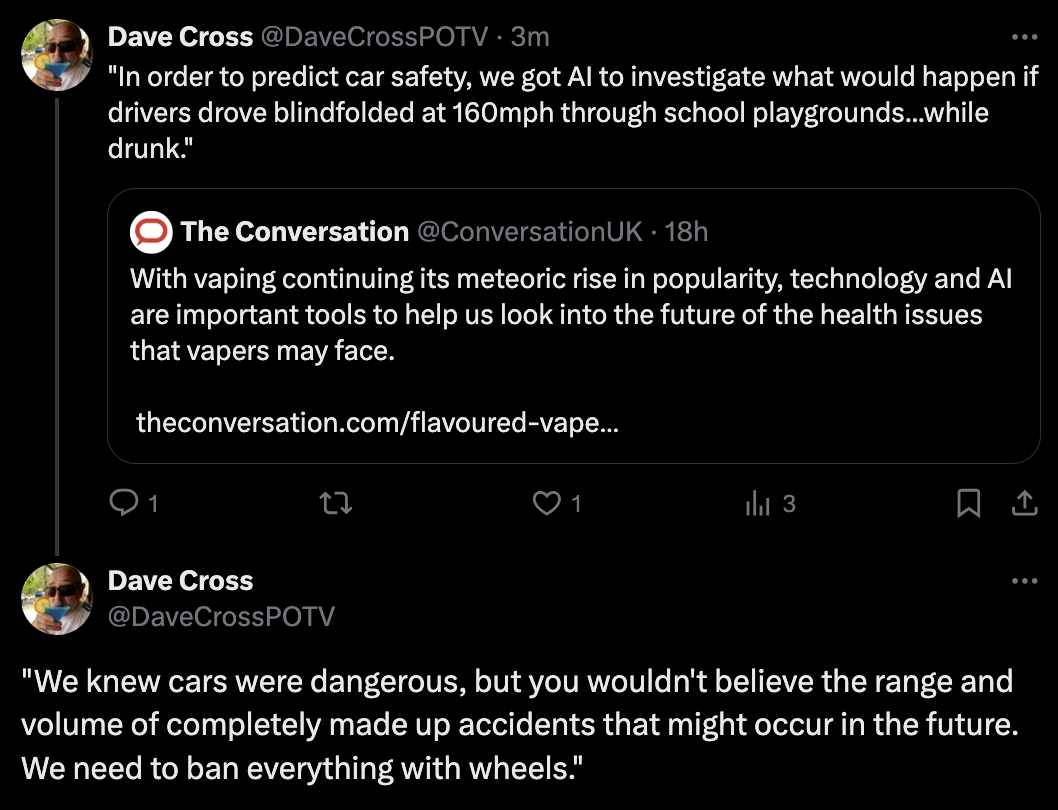A research paper from the Royal College of Surgeons in Ireland claims that artificial intelligence has discovered a cocktail of toxins in vape products. Irish media, then UK newspapers, rejoiced at the news. Long standing opponents of vaping tweeted their excitement at the prospect of vapers dying from cancer. Is this the smoking gun that proves vaping is dangerous – far more so than anyone previously thought?
‘Watch out for the hazardous health risks from flavoured vapes’, screamed the Royal College of Surgeons in Ireland (RCSI). It says its work, “highlights the urgent need for public health policies”.
It explained: “The research team in RCSI’s Department of Chemistry used artificial intelligence (AI) to simulate the effects of heating e-liquid flavour chemicals found in nicotine vapes. They included all 180 known e-liquid flavour chemicals, predicting the new compounds formed when these substances are heated within a vaping device immediately prior to inhalation.”
It says it found:
- many hazardous chemicals
- 127 that are classified as ‘acute toxic’
- 153 that are classified as ‘health hazards’
- 225 that are classified as ‘irritants’
Lead author Professor Donal O’Shea, Professor of Chemistry and Head of Department, put on his big boy’s voice and warned: “It is plausible that we are on the cusp of a new wave of chronic diseases that will emerge 15 to 20 years from now due to these exposures. We hope this research will help people make more informed choices and contribute to the conversation on the potential long-term health risks and the regulation of vaping, which this research suggests should be comprehensive.”

If you want a TLDR of expert opinion: The paper is junk; the imagined operating conditions were extreme dry hits and it was only done because it had AI in it so would be picked up by the media.
Dr Marina Murphy, Scientific Adviser to the UK Vaping Industry Association, commented: “This is a computer-based modelling exercise using Artificial Intelligence. Only this month, an article in the highly prestigious journal Nature (Artificial Intelligence and Illusions of Understanding in Scientific Research, Nature 627, 49-58 (2024), warned against the ‘illusions of understanding’ created when researchers depend on AI to do more, while understanding less.
“E-cigarettes have been around for nearly 20 years and millions of smokers have used them to switch. The effect of overheating e-liquids has been studied extensively. This can lead to the production of carbonyls, for example, but these compounds make the vapour so caustic as to be un inhalable. Newer e-cigarettes devices are designed with built-in temperature control systems.
“Vapers want to have access to a large variety of flavours, they also want to be reassured that they are as safe as they can be. That’s not to say that anything goes, because it doesn’t. If anything, this and other work confirms that there is great variation in e-liquids and the flavours used in them. It is right to understand what happens to the e-liquid and that they be subject to thorough toxicological risk assessment and tested at different levels of exposure.
“Producing scary headlines that could see smokers thinking of switching to an e-cigarette deciding to just keep smoking and vapers returning to smoking, is not helpful however.
“Vaping has proven to be the most popular quit aid, and we need to focus less on problems and more on solutions to ensure that vapers continue to get the flavours they need to successfully quit cigarettes in the safest way possible.”
Dr Konstantinos Farsalinos wrote that the study “measured nothing, assumed pyrolysis at 300-1000oC in ecigs, and then modelled emissions. You can easily make the same conclusion for any cooked food. That is not science. They cite measurements with no relevance (e.g. performed in unrealistic conditions, with coil exposed and without any airflow), and then they assumed there is pyrolysis. In fact, one of the cited studies reported degradation is due to oxidation, not pyrolysis!”
Photo Credit:
Photo by Steve Johnson on Unsplash
Dave Cross
Journalist at POTVDave is a freelance writer; with articles on music, motorbikes, football, pop-science, vaping and tobacco harm reduction in Sounds, Melody Maker, UBG, AWoL, Bike, When Saturday Comes, Vape News Magazine, and syndicated across the Johnston Press group. He was published in an anthology of “Greatest Football Writing”, but still believes this was a mistake. Dave contributes sketches to comedy shows and used to co-host a radio sketch show. He’s worked with numerous start-ups to develop content for their websites.




-listing400.jpg)


